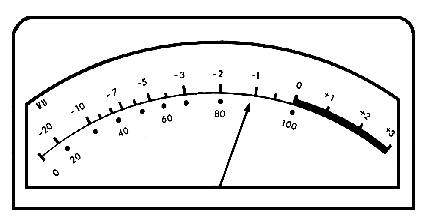VU is an abbreviation for volume unit. Thus, a VU meter is a device for measuring the level of SOUND INTENSITY with audio equipment, such as AMPLIFIERs and TAPE RECORDERs.
Although the measurements indicated on such a meter are in DECIBELs, the zero level should not be confused with 0 dB, the THRESHOLD OF HEARING. On such meters, zero indicates the maximum DISTORTION-free level that can be handled by the device with other values greater or less than the zero level indicated as positive and negative decibels relative to it respectively. See: ZERO LEVEL VU.
In practice, analog devices have considerable headroom above 0 VU to allow for peak levels; DIGITAL RECORDING systems, on the other hand, have little or no headroom because of their fixed DYNAMIC RANGE which is usually larger than with analog systems.
The diagram below shows a VU meter with a decibel scale from -20 to +3 dB, and a linear percentage of MODULATION scale from 0 to 100% below it. A meter which is linear in decibels (rather than percentage of modulation) is called a peak programme meter (PPM), and is commonly used in Britain.
Compare: GAIN, LEVEL RECORDER, OSCILLOSCOPE, SIGNAL-TO-NOISE RATIO, SOUND LEVEL METER, SOUND PRESSURE LEVEL.

VU meter where levels above 0 VU are shown as positive decibels (the range of potential distortion), and those below it as negative decibels.
home